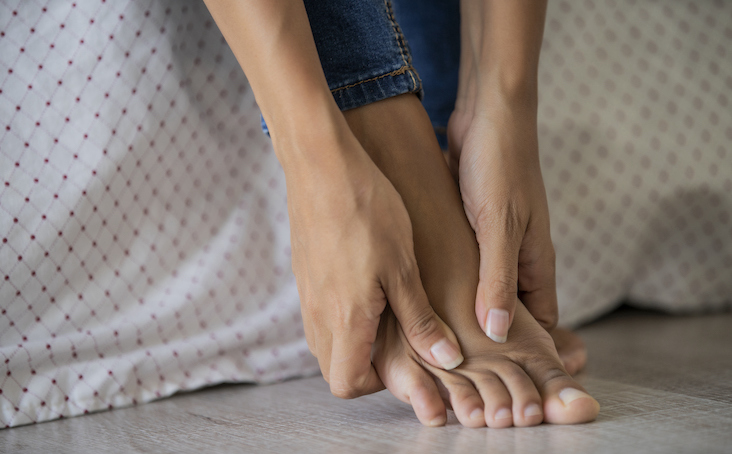TENS massagers
Transcutaneous Electrical Nerve Stimulation (TENS) foot massagers provide relief for many. These devices send electrical pulses through the skin that control pain signals in the body, creating temporary or longer-lasting relief from pain.
One popular option is the Sharper Image TENS foot massager with infrared heat. Users can adjust the electrical intensity and use the optional heat setting. Online, 86 percent of users reported that they would recommend the product to a friend who might need it.
This nonprescription device sells for less than $200, making it one of the more affordable and accessible tools available.
The Sharper Image Shiatsu Dome Foot Massager is an even more affordable option (currently $149) that soothes feet with built-in shiatsu rollers, and self-inflating and deflating air pockets on the interior of the device massage away tension and aches. Users can adjust the intensity and timer, and opt for a heated setting as well.
You can purchase Sharper Image TENS products directly from their online store.
Pain-relieving LED wraps
Medical-grade LED light, with an 850- to 890-nanometer (nm) range is believed to ease discomfort caused by arthritis, tendonitis, sprains, and neuropathy.
It remains under scientific study, but the idea is that the light penetrates beneath the skin to increase circulation, reduce swelling, and temporarily relieve pain. Many people currently rely on these LED light products for temporary relief.
A few products in this space to explore include:
Nevro Senza
Nevro Corp., a Northern California-based company, recently received Food and Drug Administration (FDA) approval to release a new advanced pain relief system called Senza or “HFX.”
This technology focuses on spinal cord stimulation (SCS), which has actually been used for nearly 30 years, but Nevro has created a completely novel approach. Their solution uses 10 kHz therapy to target patients with painful diabetic neuropathy pain superior relief and no paresthesia.
This is now the first (and only!) FDA-approved drug-free implantable device to treat chronic
This device is implanted in your body near your lower spine with a quick procedure at either your doctor’s office or an outpatient clinic.
The mild electrical pulses are delivered to your spinal cord when needed for relief that can be felt in multiple places, including the arms, legs, feet, and toes. These pulses are aimed to calm the nerves and reduce the pain signals interpreted by the brain. You can learn more about this new technology from DiabetesMine here.
The out-of-pocket costs for this Nevro solution can be significant at $7,000 to $10,000, but according to marketing director Meredith Vornholt, it is covered by all major insurance plans including Medicare, which generally covers spinal cord stimulation very well. The actual amount you would pay depends on your plan specifics for copays, coinsurance, and deductible amounts.
Patients can first try this device in a temporary 1-week trial to decide if it’s right for them. The trial period runs from 7 to 14 days. If you achieve greater than 50 percent pain relief, then you will be recommended to move forward to the next phase, which is the implant procedure.
Click here to find a pain management provider experienced with Senza near you.
Kuru Footwear
Don’t forget about shoes!
Kuru special neuropathy shoes are some of the best on the market for people with painful neuropathy caused by diabetes. Uncomfortable shoes can make neuropathy pain significantly worse, but the beauty of these shoes is that they adapt to fit your foot as you walk.
The design is extremely flexible and versatile, with great designs that (frankly) do not look like traditional diabetic shoes.
These well-fitting, comfortable shoes are designed to help prevent further damage to feet and toes affected by painful neuropathy, but they can also increase comfort levels while you exercise or are just living your day-to-day life.
Recommended by podiatrists with those living with diabetes in mind, these shoes use a foam sock liner called Kurusole. The company states that the technology was designed with the help of experts to create the most comfortable shoe possible for people struggling with neuropathy pain.
These shoes may also be helpful while recovering from injury, or when dealing with shin splints, low back pain, plantar fasciitis, or arthritis.
Margaret Jean, from Grand Rapids, Michigan, has been living with T1D for 39 years. She has struggled with painful neuropathy as she’s gotten older, especially in the harsh, cold winters.
She has not yet tried Kuru shoes specifically, but tells DiabetesMine, “I try to stay as active as I can, and swimming helps when walking is too painful. Having a comfortable, reliable shoe to wear can make all the difference! I miss heels but can’t stand the pain as I’ve aged.”
Kuru shoes run from about $125 to $165, available at the manufacturer’s website.
This content was originally published here.

